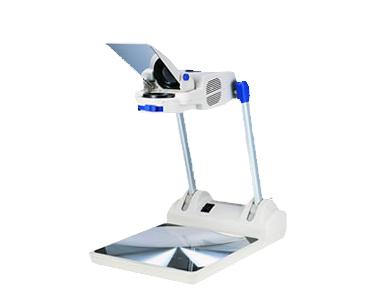One of the teaching instruments belonging to the slide projector is a slide to be displayed, and the light source directly passes through the optical device to display on the screen. During the use of the slide projector, have we understood the principle of imaging? This is very important for the use of the user, the following Xiaobian to specifically introduce the imaging principle of the slide projector, and hope to help everyone. 
1. Slide projector imaging process The slide projector lens is equivalent to a convex lens. When the slide is between the focal length of the lens and twice the focal length, the light illuminates the slide through the lens to form an enlarged, inverted real image on the screen. The slide projector with this light path feature is called a direct slide projector. The optical system of the slide projector The optical system of the slide projector includes a reflector bowl, a light source, a condenser lens, a projection lens, etc. Their role in the slide projector and their requirements are as follows:
(1) Light source Its role is to shine and shine on a slide. Requirements for the light source: Satisfy the conditions for "white light show", there should be sufficient brightness; meet the "point light source" condition, the filament arrangement area is small; the temperature near the surface of the light source is low, so as to avoid damage to the slide; there is a higher color temperature, to facilitate Color reduction; light source switch effect sensitive; long life.
The light sources commonly used in slide projectors are bromine tungsten lamps (halogen lamps) and xenon lamps. The bromine tungsten lamp has the advantages of small size, high color temperature (3,200-3,400 K), long useful life (about 200 hours), sensitive switching effect, etc., but requires transformer step-down and heat sink. The bromine lamps commonly used in slide projectors are available in 12 V/100 W, 12 V/150 W, 24 V/150 W and 24 V/250 W specifications. The xenon lamp has a high luminous efficiency of 80 lm/W while the bromine tungsten lamp is only 30 lm/W. The long service life is from 100 to several hundred hours, which is much longer than that of the bromine lamp. The color temperature is up to 5 000 K or more. , close to daylight, good color reproduction; but poor switching effect, pull the arc for a long time, triggering heavy power. Therefore, Xenon lamp projection equipment is not suitable for classroom teaching.
(2) The function of the reflective bowl of the reflector bowl is to reflect the light emitted from the light source back to the condenser lens to increase the utilization of the light energy of the light source. Reflective bowls are concave mirrors with metal-polished aluminum and silver-coated glass. Slide projectors require that the aperture of the reflective bowl is not greater than the aperture of the condenser, and the relative position of the light source should ensure that the image of the lamp coincides with the filament (ie, the filament is on the center of the concave mirror).
(3) Condenser The role of the condenser is to make the light emitted by the light source shine more and evenly on the slide, and the light that passes through the slide is collected in the focusing range of the projection lens, as shown in Figure 2-2-4. The solid angle W2 represents the solid angle formed by the light emitted from the light source into the slide when there is no condenser lens (also referred to as the inclusive angle), and W1 represents the solid angle formed by the light from the condenser light source entering the slide, apparently W1>W2. The larger the angle of containment, the more light fluxes are utilized. There are two ways to expand the angle of containment: one is to enlarge the aperture of the condenser, and the other is to shorten the distance between the condenser and the light source. The slide projector requires that the aperture of the condenser be slightly larger than the effective picture of the slide; the light source is at the focal point of the condenser.
4) Projection Lens The role of the projection lens is to form an enlarged, clear, inverted real image of a slide on the screen. Slide projectors require that the projection lens be capable of overcoming aberrations; there should be a suitable aperture so that the projection lens is within a movable range and the converged light passes through the projection lens.
At present, slide projectors use composite lenses composed of a few film lenses to reduce or even eliminate aberrations. The method of discriminating a coated lens is that the lens is blue-purple or gold-colored when viewed in the reflective direction (from the side), but it is not colored when viewed through the lens (from the front).
The projection lens is marked with focal length F and relative aperture O. Their relationship is:
Among them, D is the effective diameter of the projection lens. In general, the relative aperture O is customarily expressed as a value of 1:(F/D), for example, 1:1.2, 1:1.3, etc., indicating that the smaller the value after ":", the greater the amount of light passing through the lens per unit time.
3. The fuselage part of the slide projector is used to support various optical components, and to place slides and other accessories. It includes light boxes, film doors, film holders, lens tubes, chassis, motors, electric fans and so on. Light boxes are usually made of sheet iron or hard plastic, and the wall of the box has a ventilation window.